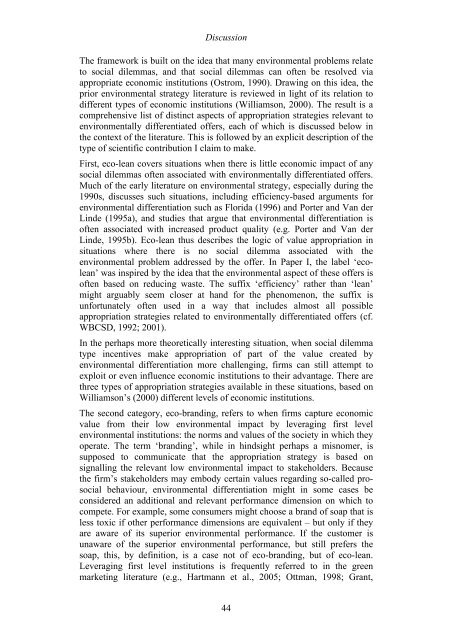Paper separationsblad - Chalmers tekniska högskola
Paper separationsblad - Chalmers tekniska högskola
Paper separationsblad - Chalmers tekniska högskola
Create successful ePaper yourself
Turn your PDF publications into a flip-book with our unique Google optimized e-Paper software.
Discussion<br />
The framework is built on the idea that many environmental problems relate<br />
to social dilemmas, and that social dilemmas can often be resolved via<br />
appropriate economic institutions (Ostrom, 1990). Drawing on this idea, the<br />
prior environmental strategy literature is reviewed in light of its relation to<br />
different types of economic institutions (Williamson, 2000). The result is a<br />
comprehensive list of distinct aspects of appropriation strategies relevant to<br />
environmentally differentiated offers, each of which is discussed below in<br />
the context of the literature. This is followed by an explicit description of the<br />
type of scientific contribution I claim to make.<br />
First, eco-lean covers situations when there is little economic impact of any<br />
social dilemmas often associated with environmentally differentiated offers.<br />
Much of the early literature on environmental strategy, especially during the<br />
1990s, discusses such situations, including efficiency-based arguments for<br />
environmental differentiation such as Florida (1996) and Porter and Van der<br />
Linde (1995a), and studies that argue that environmental differentiation is<br />
often associated with increased product quality (e.g. Porter and Van der<br />
Linde, 1995b). Eco-lean thus describes the logic of value appropriation in<br />
situations where there is no social dilemma associated with the<br />
environmental problem addressed by the offer. In <strong>Paper</strong> I, the label ‘ecolean’<br />
was inspired by the idea that the environmental aspect of these offers is<br />
often based on reducing waste. The suffix ‘efficiency’ rather than ‘lean’<br />
might arguably seem closer at hand for the phenomenon, the suffix is<br />
unfortunately often used in a way that includes almost all possible<br />
appropriation strategies related to environmentally differentiated offers (cf.<br />
WBCSD, 1992; 2001).<br />
In the perhaps more theoretically interesting situation, when social dilemma<br />
type incentives make appropriation of part of the value created by<br />
environmental differentiation more challenging, firms can still attempt to<br />
exploit or even influence economic institutions to their advantage. There are<br />
three types of appropriation strategies available in these situations, based on<br />
Williamson’s (2000) different levels of economic institutions.<br />
The second category, eco-branding, refers to when firms capture economic<br />
value from their low environmental impact by leveraging first level<br />
environmental institutions: the norms and values of the society in which they<br />
operate. The term ‘branding’, while in hindsight perhaps a misnomer, is<br />
supposed to communicate that the appropriation strategy is based on<br />
signalling the relevant low environmental impact to stakeholders. Because<br />
the firm’s stakeholders may embody certain values regarding so-called prosocial<br />
behaviour, environmental differentiation might in some cases be<br />
considered an additional and relevant performance dimension on which to<br />
compete. For example, some consumers might choose a brand of soap that is<br />
less toxic if other performance dimensions are equivalent – but only if they<br />
are aware of its superior environmental performance. If the customer is<br />
unaware of the superior environmental performance, but still prefers the<br />
soap, this, by definition, is a case not of eco-branding, but of eco-lean.<br />
Leveraging first level institutions is frequently referred to in the green<br />
marketing literature (e.g., Hartmann et al., 2005; Ottman, 1998; Grant,<br />
44















